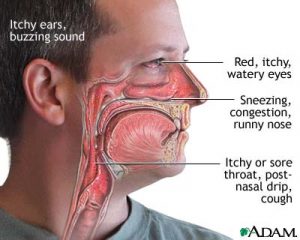Alternate Names : Hay fever, Nasal allergies
Definition
Allergic rhinitis is a collection of symptoms, mostly in the nose and eyes, which occur when you breathe in something you are allergic to, such as dust, dander, or pollen.
This article focuses on allergic rhinitis due to outdoor triggers, such as plant pollen. This type of allergic rhinitis is commonly called hay fever.
For information on other types of allergies, see:
* Allergies
* Allergy to mold, dander, dust
* Asthma
Overview, Causes, & Risk Factors
An allergen is something that triggers an allergy. When a person with allergic rhinitis breathes in an allergen such as pollen or dust, the body releases chemicals, including histamine. This causes allergy symptoms such as itching, swelling, and mucus production.
Hay fever involves an allergic reaction to pollen. (A similar reaction occurs with allergy to mold, animal dander, dust, and similar inhaled allergens.)
The pollens that cause hay fever vary from person to person and from region to region. Large, visible pollens are seldom responsible for hay fever. Tiny, hard to see pollens more often cause hay fever. Examples of plants commonly responsible for hay fever include:
* Trees (deciduous and evergreen)
* Grasses
* Ragweed
The amount of pollen in the air can play a role in whether hay fever symptoms develop. Hot, dry, windy days are more likely to have increased amounts of pollen in the air than cool, damp, rainy days when most pollen is washed to the ground.
Some disorders may be associated with allergies. These include eczema and asthma.
Allergies are common. Your genes and environment may make you more prone to allergies.
Whether or not you are likely to develop allergies is often passed down through families. If both your parents have allergies, you are likely to have allergies. The chance is greater if your mother has allergies.
Pictures & Images
Allergy symptoms
 The immune system normally responds to harmful substances such as bacteria, viruses and toxins by producing symptoms such as runny nose and congestion, post-nasal drip and sore throat, and itchy ears and eyes. An allergic reaction can produce the same symptoms in response to substances that are generally harmless, like dust, dander or pollen. The sensitized immune system produces antibodies to these allergens, which cause chemicals called histamines to be released into the bloodstream, causing itching, swelling of affected tissues, mucus production, hives, rashes, and other symptoms. Symptoms vary in severity from person to person.
The immune system normally responds to harmful substances such as bacteria, viruses and toxins by producing symptoms such as runny nose and congestion, post-nasal drip and sore throat, and itchy ears and eyes. An allergic reaction can produce the same symptoms in response to substances that are generally harmless, like dust, dander or pollen. The sensitized immune system produces antibodies to these allergens, which cause chemicals called histamines to be released into the bloodstream, causing itching, swelling of affected tissues, mucus production, hives, rashes, and other symptoms. Symptoms vary in severity from person to person.
Allergic rhinitis

Allergic rhinitis, or hay fever, is a collection of symptoms, predominantly in the nose and eyes, to allergens such as dust, dander and pollen. The sensitized immune system produces antibodies to these allergens, which cause chemicals called histamines to be released into the bloodstream, causing itching, swelling of affected tissues, mucus production, hives, rashes, and other symptoms. Symptoms vary in severity from person to person.
Recognizing invader

An allergy occurs when the immune system reacts to substances (allergens) that are generally harmless and in most people do not cause an immune response. Antibodies are formed by the immune system in response to the presence of an antigen such as pollen, mold, dust or dander.
Allergic rhinitis: Overview, Causes
Allergic rhinitis: Symptoms & Signs, Diagnosis & Tests
Allergic rhinitis: Treatment
Reviewed By : A.D.A.M. Editorial Team: David Zieve, MD, MHA, Greg Juhn, MTPW, David R. Eltz. Previously reviewed by Stuart I. Henochowicz, MD, FACP, Associate Clinical Professor of Medicine, Division of Allergy, Immunology, and Rheumatology, Georgetown University Medical School (5/25/2009).
